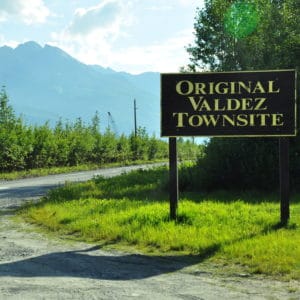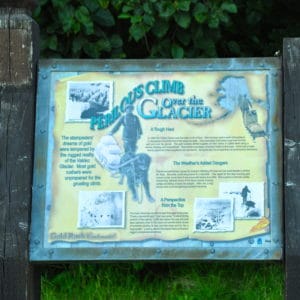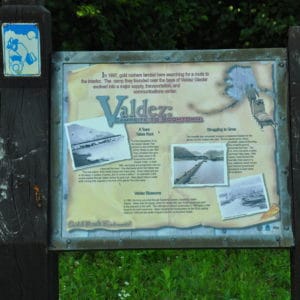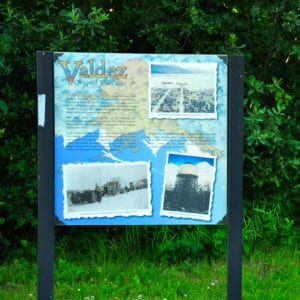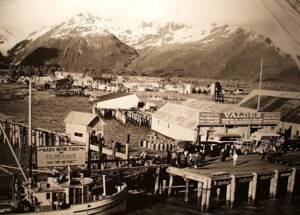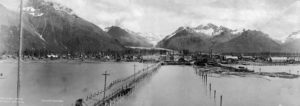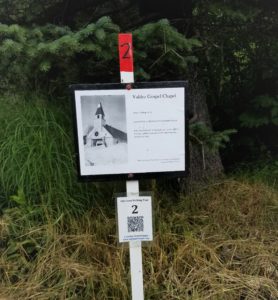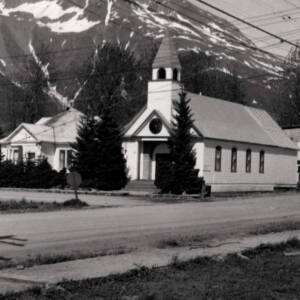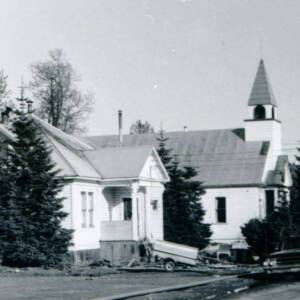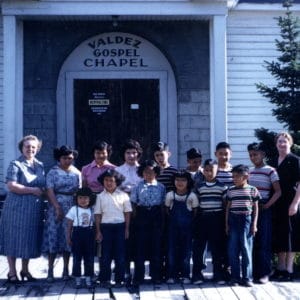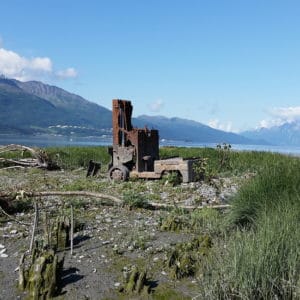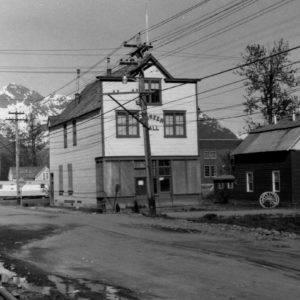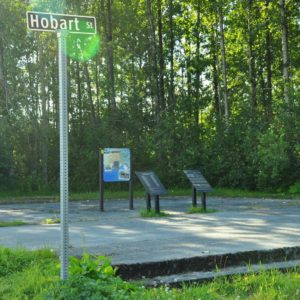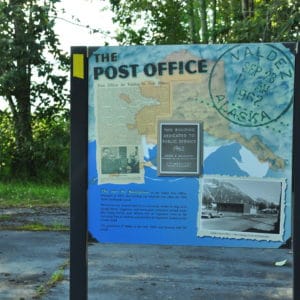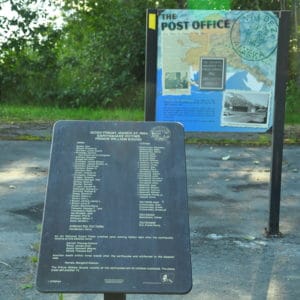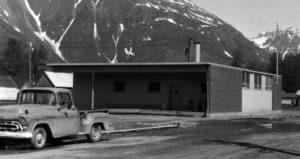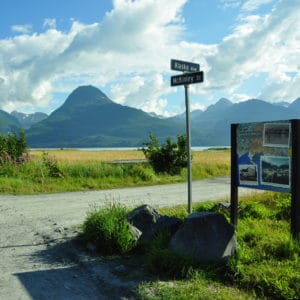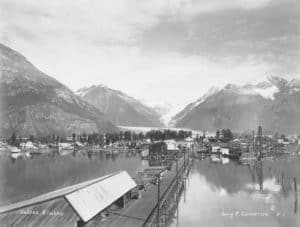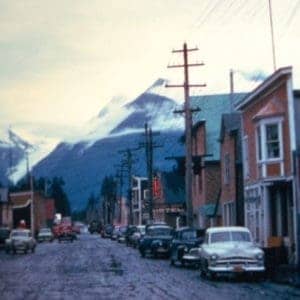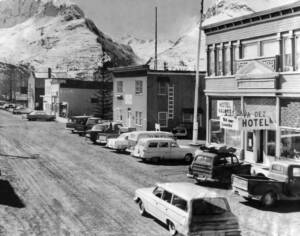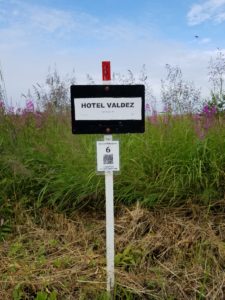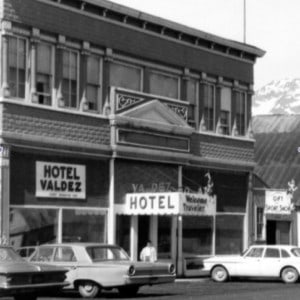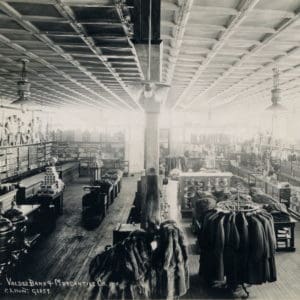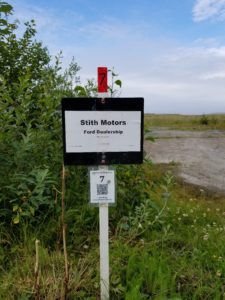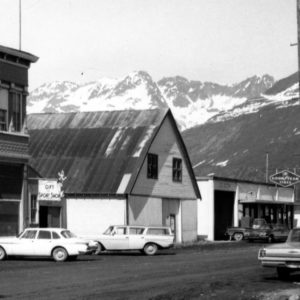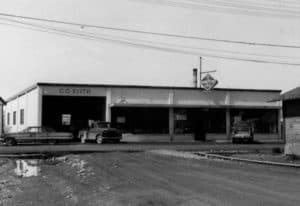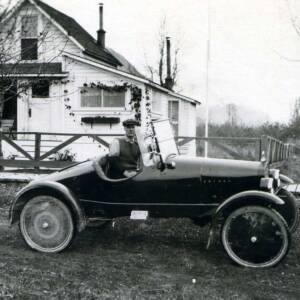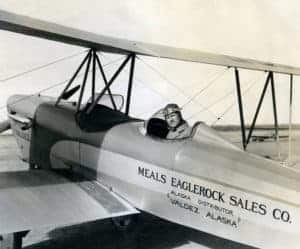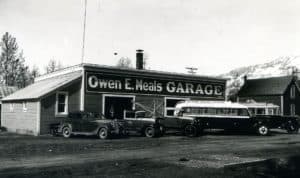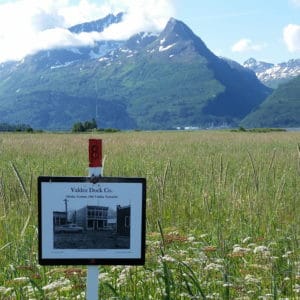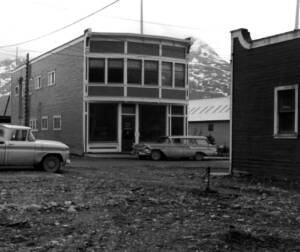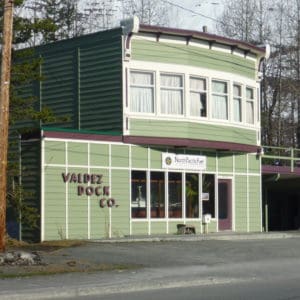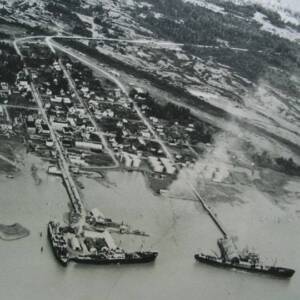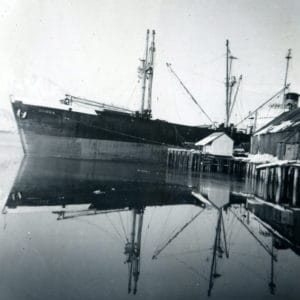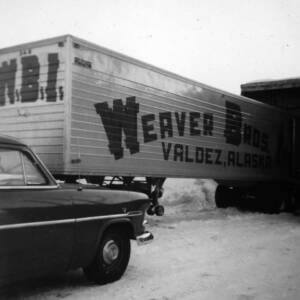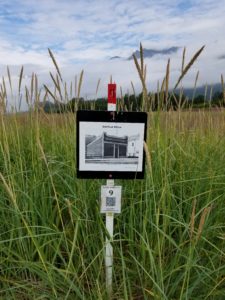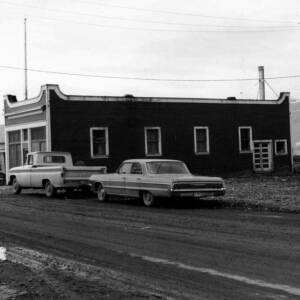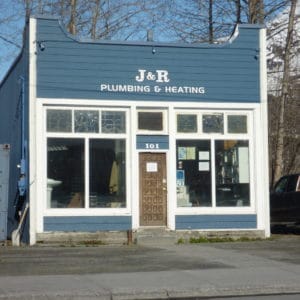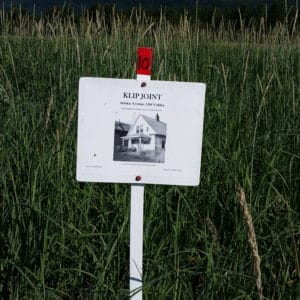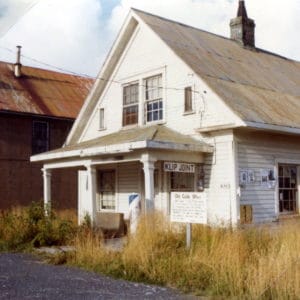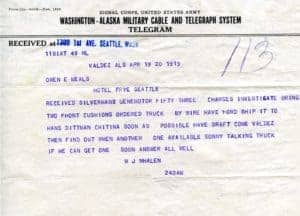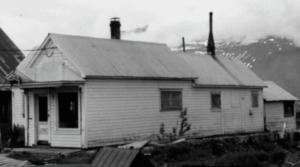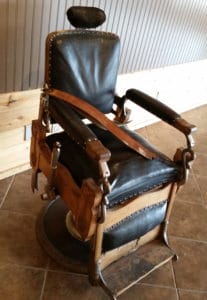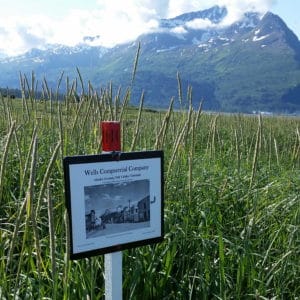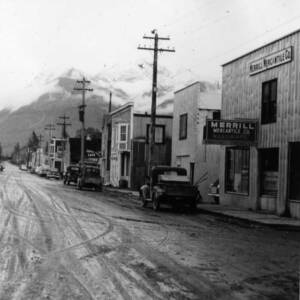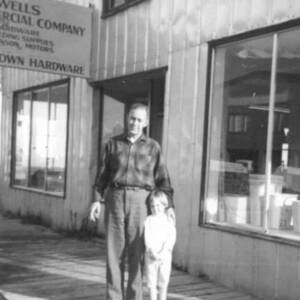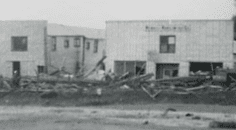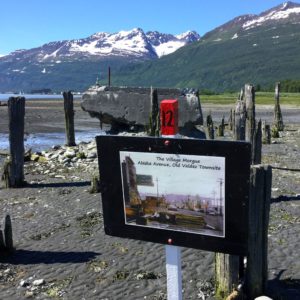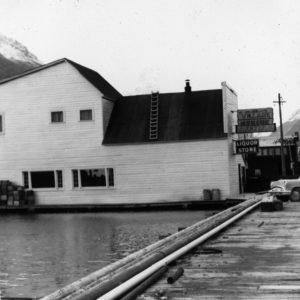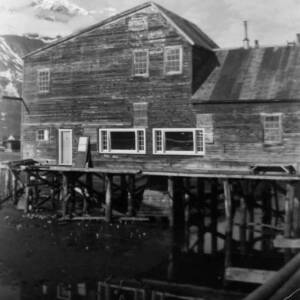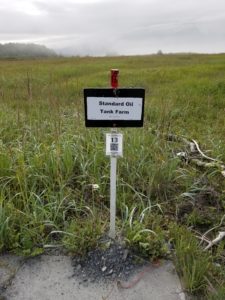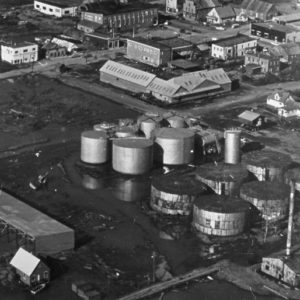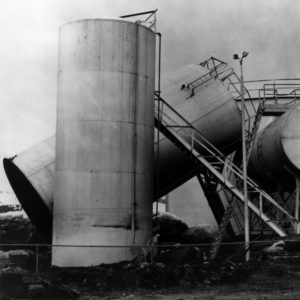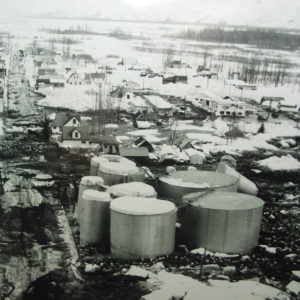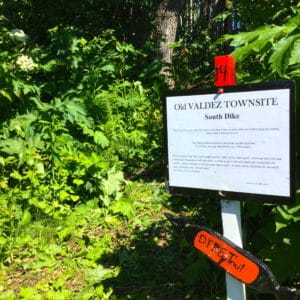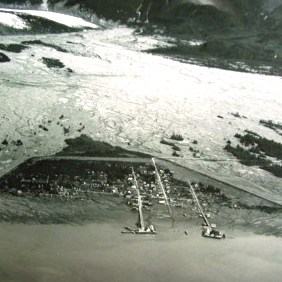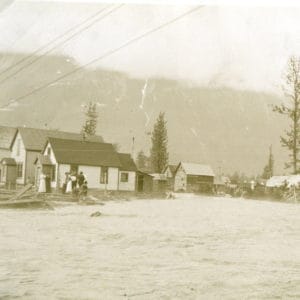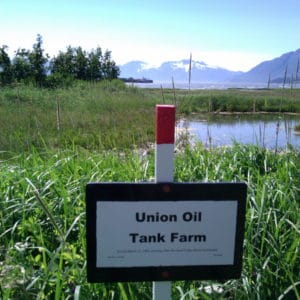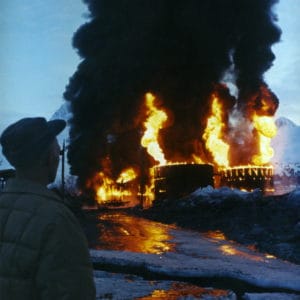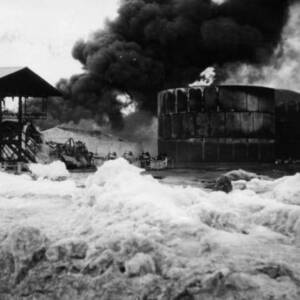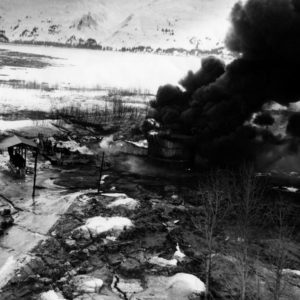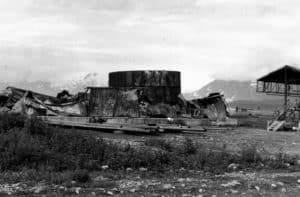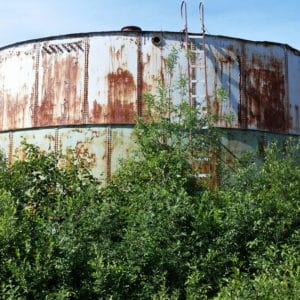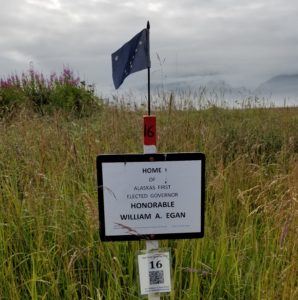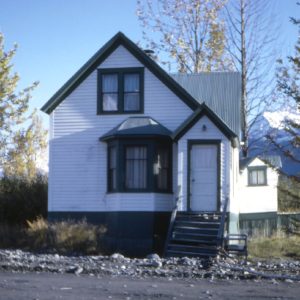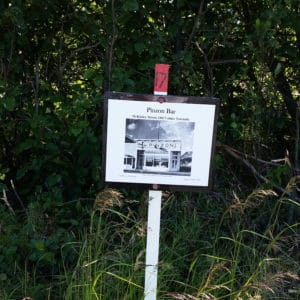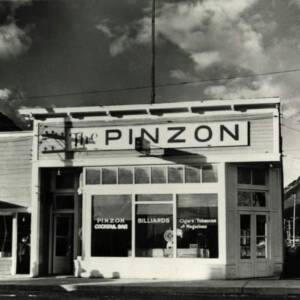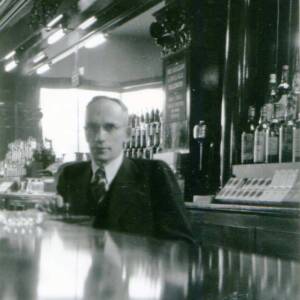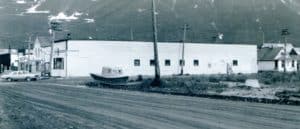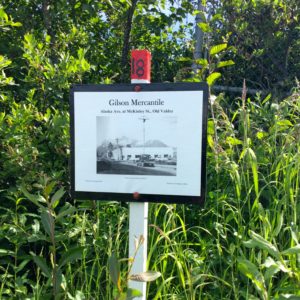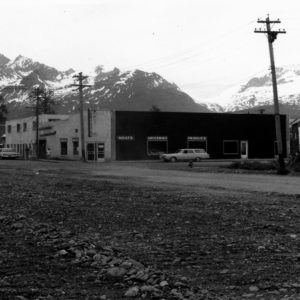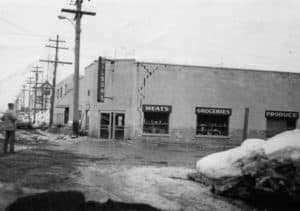Old Town Walking Tour
To use the various QR Codes found on the walking tour, please download a freely available reader for either Android or Apple.
PDF Map

Interactive Map
Click on map numbers for information about each historic site.
Old Town Walking Tour
Virtual Walking Tour of Old Town
1. Interpretive Panels
1. Interpretive Panels: A pull-out with signage about historical Valdez
The intersection of Alaska Avenue and Richardson Highway signifies the main route into the original Valdez town site and beginning of the walking tour. Little remains in evidence of the town after the 1964 Earthquake, the second largest recorded in history at 9.2. Stops along the tour were chosen for ease of access and to help bring the story of this community to life.
With the onset of the 1898 Gold Rush and arrival of prospectors to Port Valdez, it became the gateway to the Interior and ultimately an important hub for the shipment of the mail and goods and services to remote regions. It remains the northernmost ice-free port in North America situated at the very beginning of the Richardson Highway and the terminus of the Trans-Alaska Pipeline.
Old Town was not destroyed during the earthquake and resulting local tsunami, but remained home to residents for three years thereafter while a new town site was prepared for habitation. Those structures not relocated to New Valdez were destroyed along with street signs and markers. The controlled burning of the town occurred three years after the earthquake. For most locals the 1967 fires and razing of their town and homes was a somber affair. Few watched.
Back to Interactive Map
2. Valdez Gospel Chapel
2. Valdez Gospel Chapel, 406 Sherman Street
Associated with the Assemblies of God Church, the “chapel” ran a children’s home on the same block. Two tall Spruce trees remain from Old Town and flag the church’s entrance. The church’s bell located in a handsome tower, rang out on Sundays calling the local congregation to service. The church, itself, did not move to New Valdez, but the bell found a new home there.
Native Alaskan children, some siblings, others orphaned or living with a single parent unable to care for them, resided in the children’s home. They attended Valdez public schools and played in a treehouse situated nearby.
Rev. Duane Carriker, pastor of the church, also earned his living as a longshoreman and forklift operator on the Valdez docks. Carriker perished in the 1964 Earthquake. Thereafter, Mrs. Carriker and the boarded children were transported first to Fairbanks, and the children later relocated to Juneau and another Assemblies of God home. Mrs. Carriker continued to pursue the life of a missionary.
Back to Interactive Map
3. Pioneers of Alaska Hall
3. Pioneers of Alaska Hall, Hobart and Alaska Avenue This two-story structure was a meeting place for the Pioneers of Alaska, Igloo #7 and Women’s Auxiliary #2. It did not relocate to New Valdez. The Pioneers provided civic and social opportunities in Old Town, and preserved the history and fame of the early pioneers, including the town’s founders. The Fraternal Order of the Pioneers, established in Nome, Alaska, in 1907 today includes sixteen men’s and women’s igloos. A criterion for membership requires that you reside in Alaska for twenty years. The Pioneers, long involved in legislating fish and game laws and garnering support for the elderly, also played a key role in bringing Alaska into statehood.
Back to Interactive Map4. Interpretive Panel
4. Interpretive Panel: U.S. Post Office and Earthquake Victims Memorial (parking)
Built in 1962, this Kennedy-era red brick and glass block simple rectangular structure and the second Old Town post office, didn’t show signs of damage caused by fissures during the 1964 Earthquake due to its design and incorporation of a heavily-reinforced concrete pad. Some uneven settlement appears to have taken place however. The foundation remains and supports a memorial to the thirty-two residents of Valdez, four National Guardsmen who came to the town’s aid, and Chenega villagers, who died March 27, 1964.
Four successive waves advanced into Old Town after the earthquake. The fourth and final wave brought water one third of the way into town to a depth of two feet near Hobart Street where the post office sits. A new post office was built in New Valdez.
Transported via air and truck, the mail and newspapers arrived daily in Valdez and weekly by ship, regularly linking what some would call a remote region to the rest of the world.
Prince William Sound 1964 Earthquake Victims Memorial
Old Town Residents Who Died in the 1964 Earthquake:
Daniel Boddy
Fred “Freddy” O. Brown
Rev. Duane Carriker
Dennis M. Rutledge (Cunningham)
Douglas Granger
Paul Gregorieff
David Lee Growden
James Wilson Growden
James Wilson Growden, Jr.
Margaret Keenan Harrais
Robert P. Harrison
Harry Henderson
Sam Johnson
Chester G. Joslyn
Stanley Knutsen
Howard Kraiger
Georgia “Pat” Kulstad
Ross A. McCoy
Donald Mueller
Donald M. O’Leary
Richard J. Robinson
William W. Schmidt
Sterlin O. Stapp
Debra L. Stuart
Earl L. Stuart
Janice L. Stuart
Larry P. Stuart
George T. Tabasco
Ralph E. Thompson
Jack Van Buskirk
Phillip G. Wheeler
Milton T. Williams
Gerald L. Zook
Back to Interactive Map
5. Interpretive Panel at McKinley St and Alaska Ave
5. Interpretive Panel: “This was Home.” Alaska Avenue and McKinley Street
McKinley Street encompasses much of the once six block square business district in Old Town. It runs northwest and southeast, previously lined with retail shops, a bank, hotels, grocery stores and a car dealership. It was the summer parade route for the annual Gold Rush Days celebration begun in 1962, commemorating the 1898ers who landed on Valdez’ shores in search of gold, fame and fortune.
Alaska Avenue connected the waterfront and ships arriving from Seattle at its main dock to the Richardson Highway. It ran northeast and southwest on its way out of town and in-between hotels, restaurants, bars, the original post office and a hardware store.
Residents welcomed the arrival of mail and groceries via ships such as the Chena which docked on Alaska Avenue. Trucks filled from steamers’ caches carried freight to Fairbanks along this key thoroughfare.
Alaska Avenue, a state road, was paved while McKinley Street was not. Gravel thoroughfares in Old Town proved dry and dusty in warm weather and muddy in spring during annual run off and flooding from Valdez Glacier streams. Boardwalks skirted the roadways and ensured that pedestrians remain relatively high and dry.
Valdez’s story is one of boom and bust. What distinguishes the town from other pioneer settlements, is its strategic location making it the gateway to the Interior.
Back to Interactive Map6. Hotel Valdez
6. Hotel Valdez, 419 McKinley Street
Constructed in 1907 as a general store, then converted into a hotel in 1940, this two story brick building was located at 419 McKinley Street. When a fire broke out in the late 40s, it was used by Gilson Mercantile temporarily as a grocery store, then returned to use as a hotel in 1963.
Legate’s Taxi Service, a one story concrete block addition on the south side of the building constructed using neither grout nor rebar supports, didn’t fare well in the 1964 Earthquake. The quake caused a submerged landslide along the shoreline that displaced considerable water and brought about a local tsunami and series of four successive waves. These bounced off the opposite end of the bay like water sloshing in a bathtub, and flowed into Valdez.
Floodwaters rose up to six feet along McKinley Street. High tides reached a third of the way into town. Land masses dropped nine feet and shifted sideways. Silt deposited in and around buildings. Two and a half feet of water flooded the gift shop in the Hotel Valdez. The structure did not relocate to the new town site.
Back to Interactive Map7. Stith Motors
7. Stith Motors, 503 McKinley Street
A Ford dealership located at 503 McKinley Street until 1960, Stith’s original cement foundation is still in evidence. A new owner closed the auto business and re-purposed the edifice to sell hardware and building materials. A three-bedroom residence was located adjacent to the store on the east side.
Stith Motors supplanted the original Owen Meal’s Ford dealership in Old Town. An entrepreneur and visionary, Meals sold cars at the onset of a change in transportation modes on the Richardson Highway away from dog and horse-drawn conveyances to 90% motorized vehicles. Meals also introduced Old Towners to the airplane.
Neither the Stith business nor residence relocated to New Valdez.
Back to Interactive Map8. Valdez Dock Company
8. Valdez Dock Company, 122 Alaska Avenue
The second story bay window features prominently in this wooden structure. Originally built in 1914, it was destroyed in the July 15, 1915 fire that encompassed and leveled 50 buildings in the town. Rebuilt in 1916 to last thereafter, it relocated to new Valdez at 201 Hazelet Avenue.
The Kelsey family ran the dock company until 1989 and employed four to five hundred longshoremen after WWII. Shipping of freight and oil has always been important to the economy of Valdez.
The 10,000-ton cargo freighter S.S. Chena brought supplies to Valdez on Good Friday, March 27, 1964. Children and families gathered on the dock to meet the ship and catch candy and fruit thrown to them by shipmates. Tragically, these twenty-eight adults and children did not survive the earthquake that struck at 5:36 pm. A section of the coastline slid into the sea, taking the dock and people with it.
Destruction of portions of the Richardson Highway and loss of the city dock severely curtailed Old Town’s main industry, cargo transportation. Both the fishing industry and tourism were impaired, too. The damage to Valdez’s ports and harbors alone was estimated to cost about $3.6 million.
Back to Interactive Map9. Post Office 1916-1960
9. Post Office, 129 Alaska Avenue
Located at 129 Alaska Avenue opposite the Valdez Dock Company, this building served as the U.S. Post Office from 1916 until the early 1960s when a new facility opened on Hobart Street. The structure survived the 1964 Earthquake and relocated to new Valdez at 101 Hazelet Avenue.
The Valdez Dock Company built the post office realizing that Valdez was a pivotal mail-distribution center for the rest of Alaska. Early on mail came from Seattle on steamship and was sent to the Interior via dog-sled, horse-drawn sledge and carriage, and in later years by truck.
Back to Interactive Map10. Klip Joint
10. Klip Joint, 115 Alaska Avenue
In the early 1960s, this was the only barber shop in town, run by proprietor Ethel McDougald Rhoden. During the 1964 Earthquake, Rhoden cut short client Jerry Bellezza’s time in her barber’s chair, now on display at the Valdez City Visitor’s Bureau. Rhoden added a rear room as a play area for her two children.
The Klip Joint was originally a cable office and home to the Alaska Communication System. An overland telegraph line ran north from Valdez to Eagle and branched west to Fairbanks and Tanana, following a similar route to the Interior as the Richardson Highway.
The Klip Joint did not relocate to the new town site.
Back to Interactive Map11. Wells Commercial Company
11. Wells Commercial Company, 62 Alaska Avenue
In 1952 Max Wells purchased and expanded the Merrill Mercantile Company. Sometimes, called the “Sears” of Valdez, Wells sold essentials from lumber to toys to washing machines on the ground floor. Old Towners recall him weighing new born Valdez babies in the nail scoop before the hospital was built, too.
Eight members of the Wells family resided on the second floor of the store and in a one-story section at the rear set aside for Grandma Wells. Max Wells yelled to the household to run to higher ground during the violent shaking of the 1964 Earthquake. He grabbed his young daughter Laura “like a sack of sugar.” Son Jason, picked up baby Teddy. Betty Wells navigated the chaotic streets of Old Town with her daughters supporting “grandma.” Fissures opened. Groundwater spewed upwards like geysers. Betty Wells looked back to discover a thirty-foot wave crest and fall just behind her. The family narrowly escaped.
In the aftermath of the earthquake, people fled to neighboring communities. Over 200 refugees traveled to Fairbanks, where they received temporary housing, clothing and medical attention.
Wells Commercial Company did not relocate to New Valdez.
Back to Interactive Map12. Village Morgue Bar
12. Village Morgue Bar, 45 Alaska Avenue
Situated at the waterfront adjacent to the city dock, this building’s foundation comes from a stamp mill in operation from 1900-1918. Ore-bearing rock was transported to the mill, crushed and the valuable minerals separated out. The mill’s concrete footing and supporting rebar can be seen during low tide alongside dock remains.
When the bottom fell out of the gold industry the mill became a morgue, overwintering the deceased until springtime when graves could be dug. In the 1920s it morphed into a well-known bar, replete with a band comprised of bass, piano and saxophone that played on Saturday nights. Locals would say, “Meet me at the Morgue!”
“The Morgue” did not move to the new town site after the earthquake.
Back to Interactive Map13. Standard Oil Tank Farm
13. Standard Oil Tank Farm, McKinley Street
During the 1964 Earthquake oil from broken piping external to the Standard Oil tanks leached out into the water, ignited and floated, creating a dangerous fiery surface. The nearby Union Oil storage containers caught fire and later exploded. Smoke from the fires darkened the sky for days.
A third set of tanks situated between the two farms held asphalt kept molten with steam-fired boilers. Owned by the state, it was used to surface highway miles and airport runways. It was scheduled to be applied to Valdez street surfaces, paving thirty downtown blocks in the summer of 1964.
Back to Interactive Map14. South Dike
14. South Dike
The dike, built in 1907 to keep the waters of Valdez Glacier from flooding Old Town each spring, ran four miles along the three inland sides of town.
Old Town Valdez could also be deluged by the sudden release of entire ice-dammed glacial lakes associated with the Valdez Glacier. The perilous nature of the spring flooding was noted as early as 1899 by Edward Gillete, an engineer in Army Captain Abercrombie’s survey party. The glacier receded nearly one mile during the decades between Capt. Abercrombie’s report and the 1960s. Glacial runoff, though lessened, continued to hazard the town, challenging the dike system.
Back to Interactive Map15. Union Oil Tank Farm
15. Union Oil Tank Farm, McKinley Street (east)
Union Oil’s steel riveted tanks stored gas and home fuel oil. Unlike the welded containers comprising the nearby Standard Oil Company yard, Union’s tanks ruptured during the 1964 Earthquake. Gasoline housed within, caught fire and burned first, creating space in the tanks that then filled with oxygen and combusted. All but one of the tanks exploded. The cause of the rupture goes unexplained, evidence obscured by the explosions and fires.
The surviving tank, now converted into a storage shed, sits at Mark’s Repair on the Richardson Highway near the eastern boundary of Old Town.
Back to Interactive Map16. William A. Egan home
16. William A. Egan Home, 128 Broadway Avenue
William A. Egan served as the first governor of Alaska at the time of the 1964 earthquake. He and his wife Neva resided in Juneau and rented the Broadway house to the Growdens. It did not relocate to the new town site.
Governor Egan grew up nearby in his childhood home located at 5th and Alaska Avenues. He resided there with his widowed mother and seven siblings. His brother “Truck,” owner of The Pinzon Bar in Old Town, moved this family home to new Valdez after the earthquake and operated the Pinzon Liquor Store out of its front. He installed a walk-in cooler, still visible in its framework. The house is presently the Northwind Gift Shop.
Back to Interactive Map17. Pinzon Bar
17. The Pinzon Bar, 302 McKinley Street
A social gathering spot for many, especially those interested in debating politics, the “Pinzon” closed the day of the 1964 earthquake. C. J. “Truck” Egan, brother of William Egan, the first governor of Alaska, presided over this bar and billiard hall.
The 40 ft. hardwood bar, original to “The Pinzon” establishment and reportedly the longest in the Territory of Alaska is now on display at the Valdez Museum on Egan Street. Its design reflects the ornate carved style of the early 1900s.
During the 1964 Earthquake water ran high along McKinley Street to depths of five to six feet. Tidal surges are largely responsible for damage to buildings and commercial establishments located along this thoroughfare.
Back to Interactive Map18. Gilson’s Mercantile
18. Gilson Mercantile, 340 McKinley Street
The cement block building included a café, butchery and bakery, groceries, produce and sundries. Gilson ran a 400-mile delivery route monthly and provided rental apartments for truck drivers and their families. Shipping goods to the Interior via the Richardson Highway was one of the premier functions of the Valdez port.
Back to Interactive Map 
